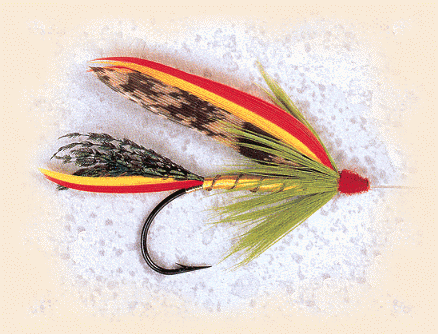"This generally very gaudy fly of crimson, gold and green was
named to honor Major J.B. Ferguson, one of Maryland's two Fish
Commissioners in 1880-82, and later of the U.S. Fish Commission.
It was orginated by the Major for Potomac River bass."
The Ferguson as described in Fly Patterns and Their
Origins, is tied:
- Body: Yellow floss.
- Rib: Gold.
- Tail: Yellow and scarlet.
- Wing: Yellow striped brown turkey wings.
- Hackle: Green.
In researching this fly, three other descriptions were found. The one
shown in the photograph above, from
Forgotten Flies is given as:
- Tag: Flat gold tinsel.
- Tail: Peacock sword, scarlet and yellow.
- Body: Yellow floss.
- Rib: Embossed gold tinsel.
- Wing: Woodcock (mottled brown) yellow and
scarlet strips.
- Hackle: Green.
- Head: Red Wool.
-
This illustration was chosen it seems to best fit the "very gaudy" description.
-
"When George S. Page attended the International Fisheries Exhibition at
Edinburgh, Scotland, in 1882, he took with him five live black bass,
raised by the Major in Druid Hill Park, Baltimore. After being exhibited,
they were presented to the Duke of Sutherland. This was the introduction
of American bass into Scotland."
-
Quoted section from Fly Patterns and Their
Origins, published by Westshore Publications,
Color photo from Forgotten Flies.
We appreciate use permission!
|



